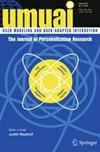在学习环境中利用响应时间:机遇与挑战
IF 3.5
3区 计算机科学
Q2 COMPUTER SCIENCE, CYBERNETICS
引用次数: 0
摘要
基于计算机的学习环境可以很容易地收集学生的反应时间。这些工具可以用于多种目的,例如建模学生的知识和影响、领域建模和作弊检测。然而,要充分利用它们,有必要了解响应时间的属性和相关的注意事项。在本研究中,我们深入探讨了反应时间分布的性质,包括异常学生行为对反应时间的影响。然后,我们概述了使用响应时间的建模方法,并讨论了响应时间在指导学习环境的自适应行为方面的潜在应用。本文章由计算机程序翻译,如有差异,请以英文原文为准。

Leveraging response times in learning environments: opportunities and challenges
Abstract Computer-based learning environments can easily collect student response times. These can be used for multiple purposes, such as modeling student knowledge and affect, domain modeling, and cheating detection. However, to fully leverage them, it is essential to understand the properties of response times and associated caveats. In this study, we delve into the properties of response time distributions, including the influence of aberrant student behavior on response times. We then provide an overview of modeling approaches that use response times and discuss potential applications of response times for guiding the adaptive behavior of learning environments.
求助全文
通过发布文献求助,成功后即可免费获取论文全文。
去求助
来源期刊

User Modeling and User-Adapted Interaction
工程技术-计算机:控制论
CiteScore
8.90
自引率
8.30%
发文量
35
审稿时长
>12 weeks
期刊介绍:
User Modeling and User-Adapted Interaction provides an interdisciplinary forum for the dissemination of novel and significant original research results about interactive computer systems that can adapt themselves to their users, and on the design, use, and evaluation of user models for adaptation. The journal publishes high-quality original papers from, e.g., the following areas: acquisition and formal representation of user models; conceptual models and user stereotypes for personalization; student modeling and adaptive learning; models of groups of users; user model driven personalised information discovery and retrieval; recommender systems; adaptive user interfaces and agents; adaptation for accessibility and inclusion; generic user modeling systems and tools; interoperability of user models; personalization in areas such as; affective computing; ubiquitous and mobile computing; language based interactions; multi-modal interactions; virtual and augmented reality; social media and the Web; human-robot interaction; behaviour change interventions; personalized applications in specific domains; privacy, accountability, and security of information for personalization; responsible adaptation: fairness, accountability, explainability, transparency and control; methods for the design and evaluation of user models and adaptive systems
 求助内容:
求助内容: 应助结果提醒方式:
应助结果提醒方式:


